

Compact Muon Solenoid
LHC, CERN
| CMS-TOP-15-018 ; CERN-EP-2019-270 | ||
| Measurement of the top quark forward-backward production asymmetry and the anomalous chromoelectric and chromomagnetic moments in pp collisions at √s= 13 TeV | ||
| CMS Collaboration | ||
| 19 December 2019 | ||
| JHEP 06 (2020) 146 | ||
| Abstract: The parton-level top quark (t) forward-backward asymmetry and the anomalous chromoelectric (ˆdt) and chromomagnetic (ˆμt) moments have been measured using LHC pp collisions at a center-of-mass energy of 13 TeV, collected in the CMS detector in a data sample corresponding to an integrated luminosity of 35.9 fb−1. The linearized variable A(1)FB is used to approximate the asymmetry. Candidate tˉt events decaying to a muon or electron and jets in final states with low and high Lorentz boosts are selected and reconstructed using a fit of the kinematic distributions of the decay products to those expected for tˉt final states. The values found for the parameters are A(1)FB= 0.048+0.095−0.087 (stat) +0.020−0.029 (syst), ˆμt=−0.024+0.013−0.009 (stat) +0.016−0.011 (syst), and a limit is placed on the magnitude of |ˆdt|< 0.03 at 95% confidence level. | ||
| Links: e-print arXiv:1912.09540 [hep-ex] (PDF) ; CDS record ; inSPIRE record ; HepData record ; CADI line (restricted) ; | ||
| Figures | |

png pdf |
Figure 1:
(a) Feynman diagrams for LO qˉq- and gg-initiated tˉt subprocesses, and (b) example diagrams for the NLO qg-initiated subprocess. |
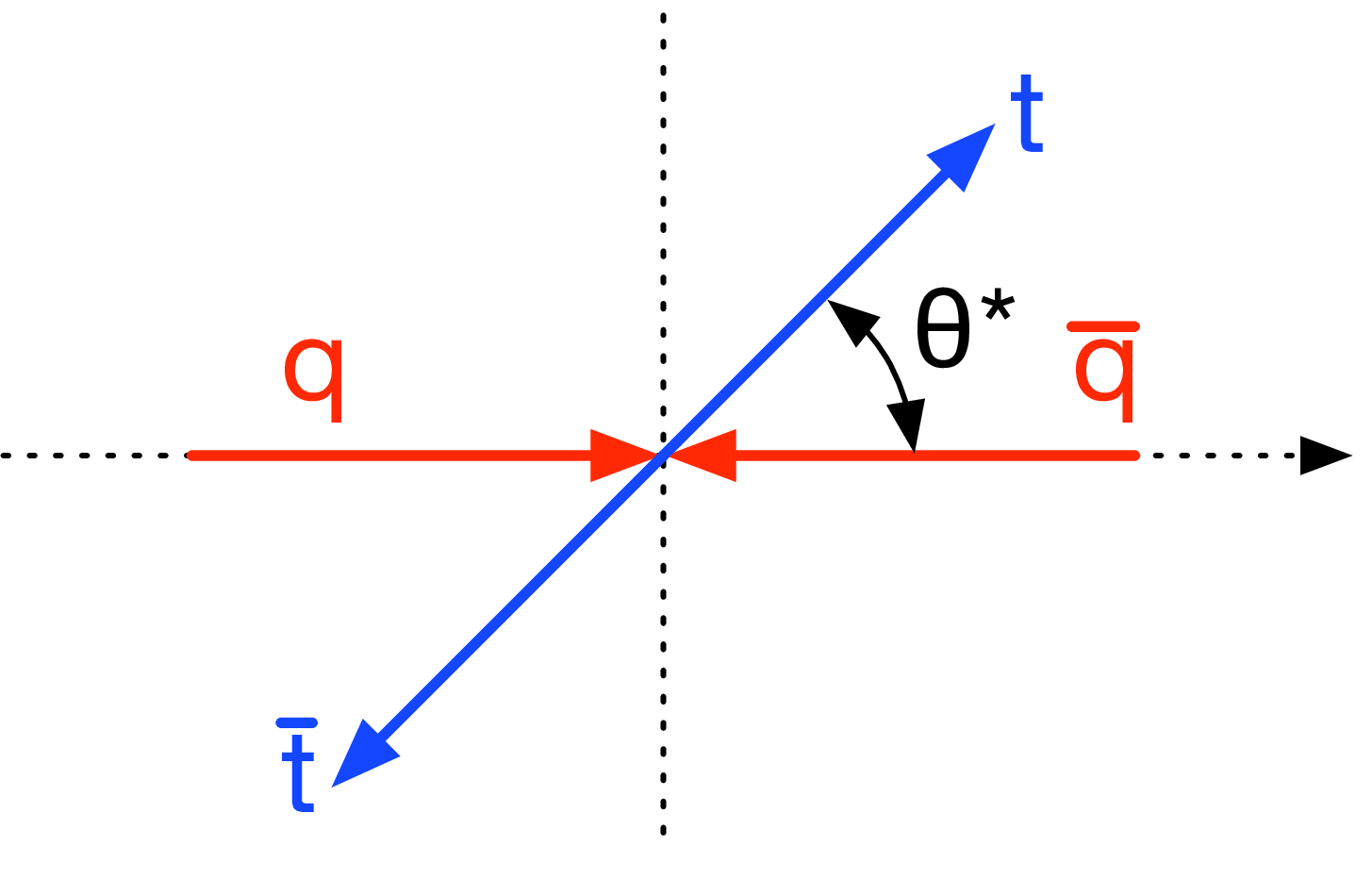
png pdf |
Figure 2:
Production angle θ∗ in a qˉq→tˉt event defined in the tˉt center-of-mass frame. |
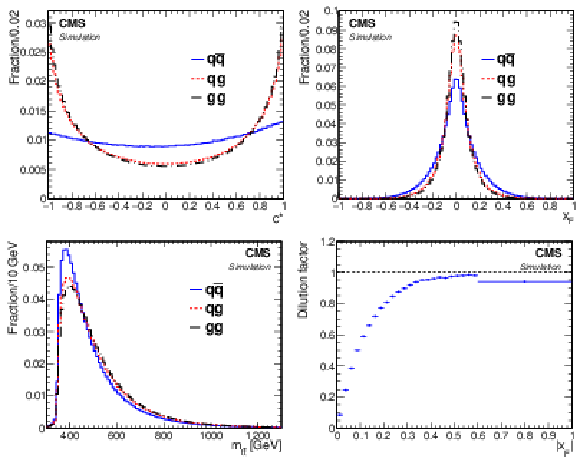
png pdf |
Figure 3:
The generator-level c∗ (upper left), xF (upper right), and mtˉt (lower left) distributions normalized to unity for the subprocesses qˉq, qg, and gg→tˉt. The dilution factor, when taking the longitudinal direction of the tˉt pair in the lab frame as the quark direction for qˉq events, is shown in the lower right plot as a function of |xF|. |
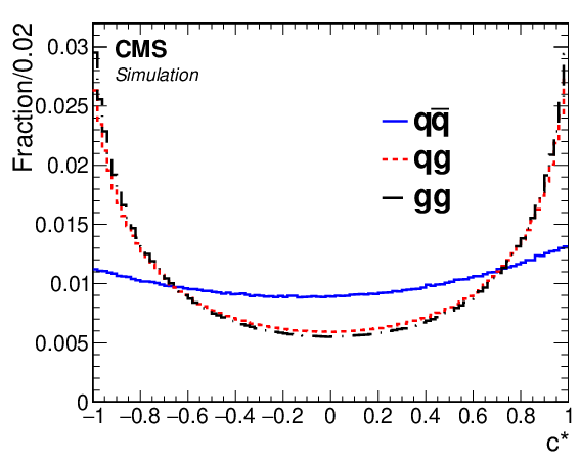
png pdf |
Figure 3-a:
The generator-level c∗ (upper left), xF (upper right), and mtˉt (lower left) distributions normalized to unity for the subprocesses qˉq, qg, and gg→tˉt. The dilution factor, when taking the longitudinal direction of the tˉt pair in the lab frame as the quark direction for qˉq events, is shown in the lower right plot as a function of |xF|. |
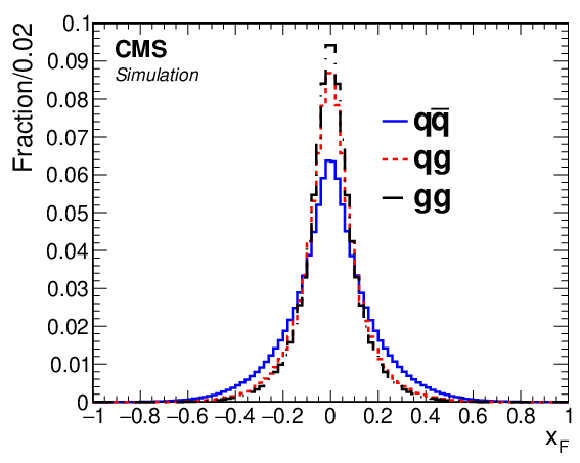
png pdf |
Figure 3-b:
The generator-level c∗ (upper left), xF (upper right), and mtˉt (lower left) distributions normalized to unity for the subprocesses qˉq, qg, and gg→tˉt. The dilution factor, when taking the longitudinal direction of the tˉt pair in the lab frame as the quark direction for qˉq events, is shown in the lower right plot as a function of |xF|. |
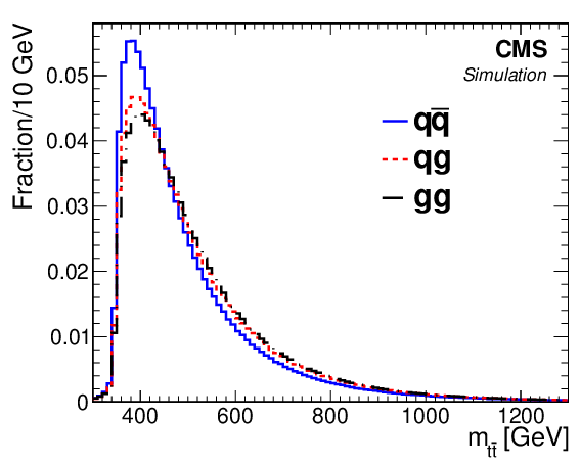
png pdf |
Figure 3-c:
The generator-level c∗ (upper left), xF (upper right), and mtˉt (lower left) distributions normalized to unity for the subprocesses qˉq, qg, and gg→tˉt. The dilution factor, when taking the longitudinal direction of the tˉt pair in the lab frame as the quark direction for qˉq events, is shown in the lower right plot as a function of |xF|. |
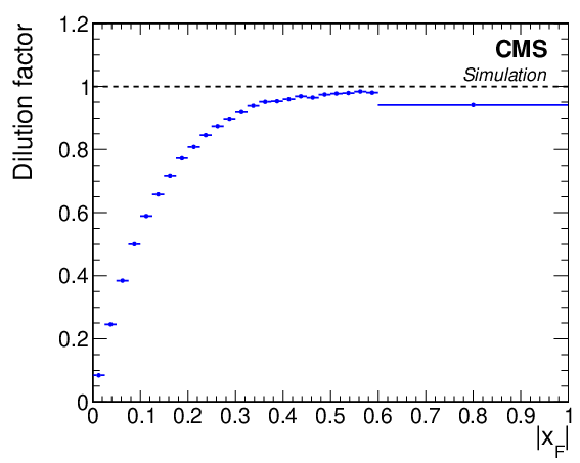
png pdf |
Figure 3-d:
The generator-level c∗ (upper left), xF (upper right), and mtˉt (lower left) distributions normalized to unity for the subprocesses qˉq, qg, and gg→tˉt. The dilution factor, when taking the longitudinal direction of the tˉt pair in the lab frame as the quark direction for qˉq events, is shown in the lower right plot as a function of |xF|. |
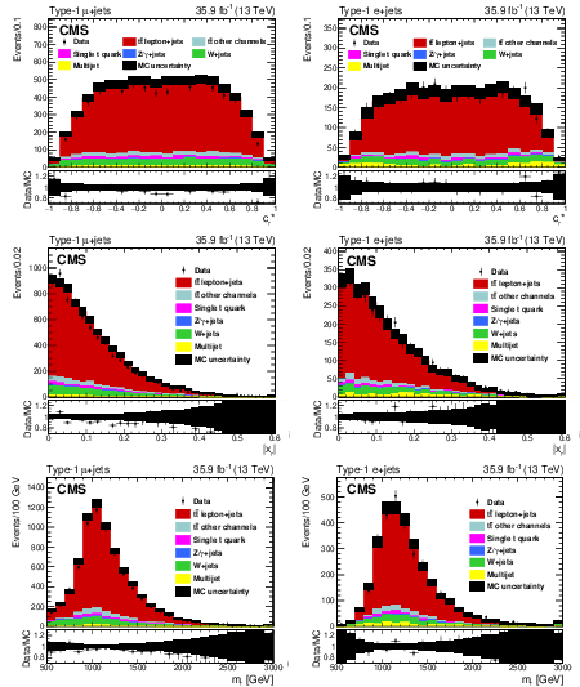
png pdf |
Figure 4:
Reconstructed c∗r (upper), |xr| (middle), and mr (lower) for events passing type-1 μ+jets (left column) and e+jets (right column) selection criteria. The uncertainty pictured in the hatched bands represents just the statistical contributions. The multijet background is estimated from data, as discussed in Section 6. The lower panels in each figure show the ratio of data to MC expectation in each bin, and the last bins of the |xr| and mr plots include overflow. |
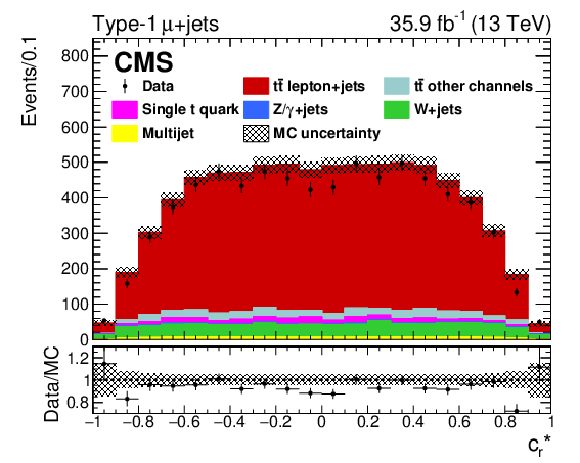
png pdf |
Figure 4-a:
Reconstructed c∗r (upper), |xr| (middle), and mr (lower) for events passing type-1 μ+jets (left column) and e+jets (right column) selection criteria. The uncertainty pictured in the hatched bands represents just the statistical contributions. The multijet background is estimated from data, as discussed in Section 6. The lower panels in each figure show the ratio of data to MC expectation in each bin, and the last bins of the |xr| and mr plots include overflow. |
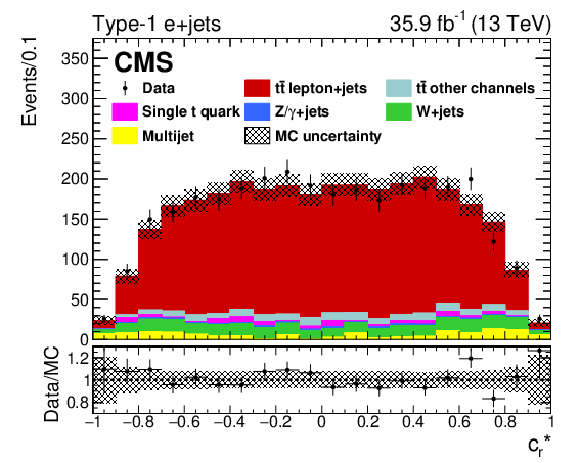
png pdf |
Figure 4-b:
Reconstructed c∗r (upper), |xr| (middle), and mr (lower) for events passing type-1 μ+jets (left column) and e+jets (right column) selection criteria. The uncertainty pictured in the hatched bands represents just the statistical contributions. The multijet background is estimated from data, as discussed in Section 6. The lower panels in each figure show the ratio of data to MC expectation in each bin, and the last bins of the |xr| and mr plots include overflow. |
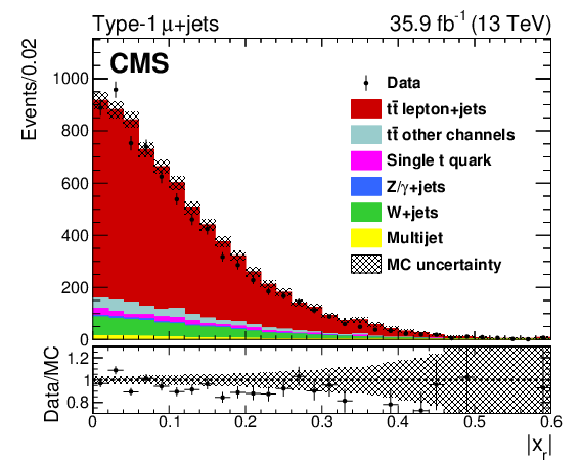
png pdf |
Figure 4-c:
Reconstructed c∗r (upper), |xr| (middle), and mr (lower) for events passing type-1 μ+jets (left column) and e+jets (right column) selection criteria. The uncertainty pictured in the hatched bands represents just the statistical contributions. The multijet background is estimated from data, as discussed in Section 6. The lower panels in each figure show the ratio of data to MC expectation in each bin, and the last bins of the |xr| and mr plots include overflow. |
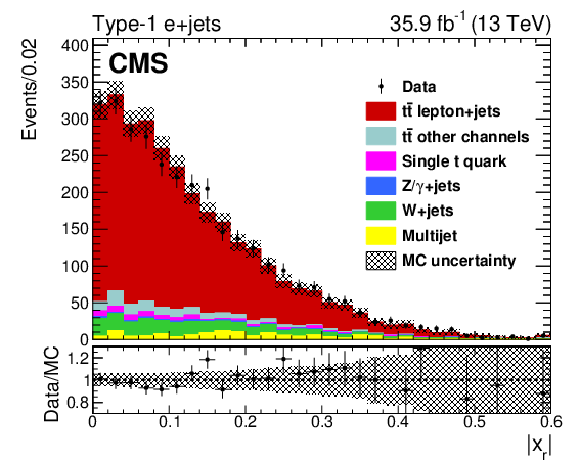
png pdf |
Figure 4-d:
Reconstructed c∗r (upper), |xr| (middle), and mr (lower) for events passing type-1 μ+jets (left column) and e+jets (right column) selection criteria. The uncertainty pictured in the hatched bands represents just the statistical contributions. The multijet background is estimated from data, as discussed in Section 6. The lower panels in each figure show the ratio of data to MC expectation in each bin, and the last bins of the |xr| and mr plots include overflow. |
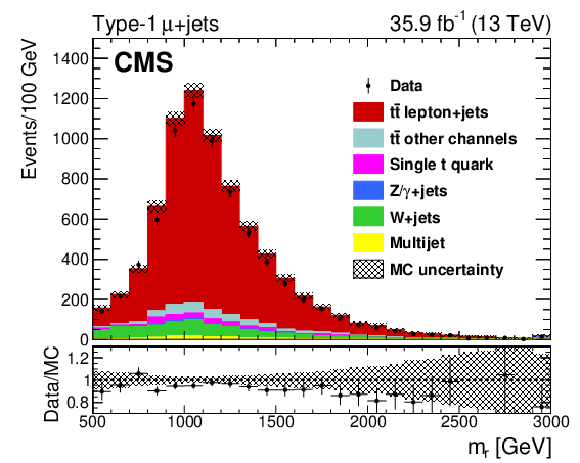
png pdf |
Figure 4-e:
Reconstructed c∗r (upper), |xr| (middle), and mr (lower) for events passing type-1 μ+jets (left column) and e+jets (right column) selection criteria. The uncertainty pictured in the hatched bands represents just the statistical contributions. The multijet background is estimated from data, as discussed in Section 6. The lower panels in each figure show the ratio of data to MC expectation in each bin, and the last bins of the |xr| and mr plots include overflow. |
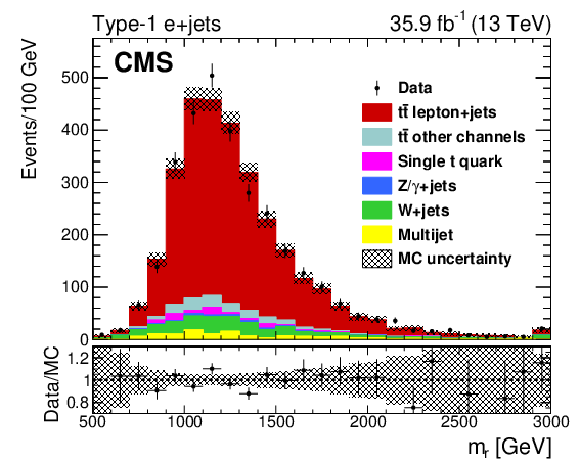
png pdf |
Figure 4-f:
Reconstructed c∗r (upper), |xr| (middle), and mr (lower) for events passing type-1 μ+jets (left column) and e+jets (right column) selection criteria. The uncertainty pictured in the hatched bands represents just the statistical contributions. The multijet background is estimated from data, as discussed in Section 6. The lower panels in each figure show the ratio of data to MC expectation in each bin, and the last bins of the |xr| and mr plots include overflow. |
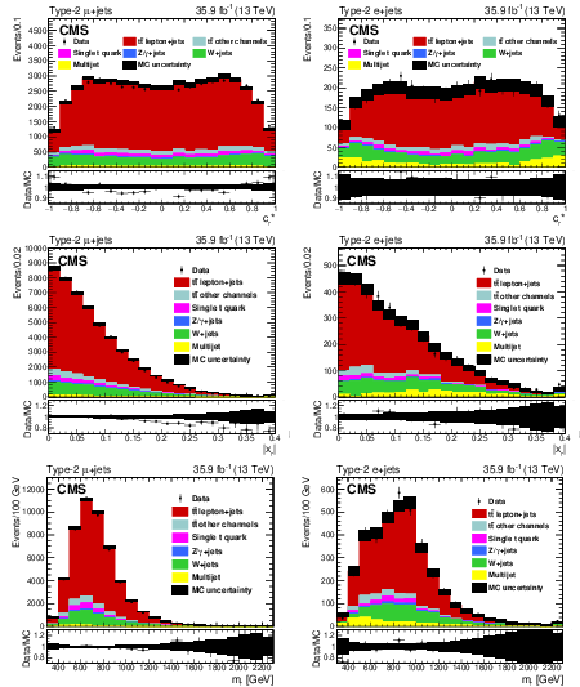
png pdf |
Figure 5:
Data/MC comparison of reconstructed c∗r (upper), |xr| (middle), and mr (lower) for events passing type-2 μ+jets (left column) and e+jets (right column) selection criteria. The MC signal and background show their nominal predictions, with the MC uncertainty pictured in the hatched bands representing statistical uncertainties. The contribution from multijet background is estimated from data, as discussed in Section 6. The lower panels of each figure show the ratio of the observed data to MC expectation in each bin, and the last bins of the |xr| and mr plots include overflow. |
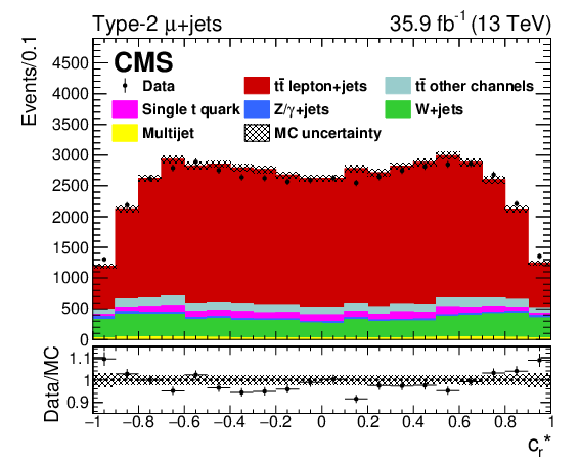
png pdf |
Figure 5-a:
Data/MC comparison of reconstructed c∗r (upper), |xr| (middle), and mr (lower) for events passing type-2 μ+jets (left column) and e+jets (right column) selection criteria. The MC signal and background show their nominal predictions, with the MC uncertainty pictured in the hatched bands representing statistical uncertainties. The contribution from multijet background is estimated from data, as discussed in Section 6. The lower panels of each figure show the ratio of the observed data to MC expectation in each bin, and the last bins of the |xr| and mr plots include overflow. |
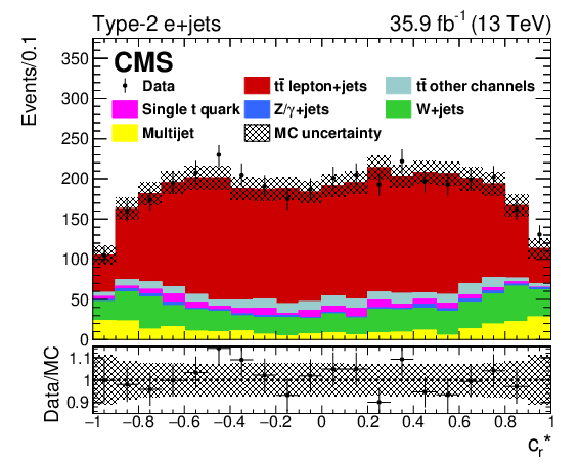
png pdf |
Figure 5-b:
Data/MC comparison of reconstructed c∗r (upper), |xr| (middle), and mr (lower) for events passing type-2 μ+jets (left column) and e+jets (right column) selection criteria. The MC signal and background show their nominal predictions, with the MC uncertainty pictured in the hatched bands representing statistical uncertainties. The contribution from multijet background is estimated from data, as discussed in Section 6. The lower panels of each figure show the ratio of the observed data to MC expectation in each bin, and the last bins of the |xr| and mr plots include overflow. |
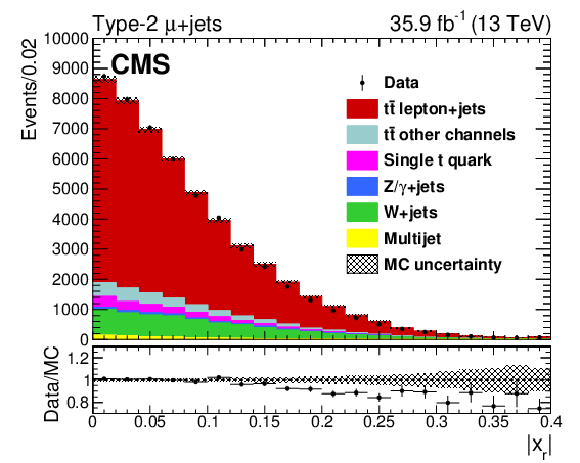
png pdf |
Figure 5-c:
Data/MC comparison of reconstructed c∗r (upper), |xr| (middle), and mr (lower) for events passing type-2 μ+jets (left column) and e+jets (right column) selection criteria. The MC signal and background show their nominal predictions, with the MC uncertainty pictured in the hatched bands representing statistical uncertainties. The contribution from multijet background is estimated from data, as discussed in Section 6. The lower panels of each figure show the ratio of the observed data to MC expectation in each bin, and the last bins of the |xr| and mr plots include overflow. |
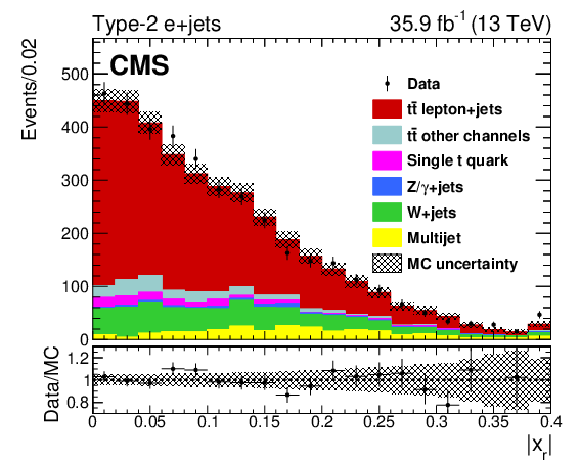
png pdf |
Figure 5-d:
Data/MC comparison of reconstructed c∗r (upper), |xr| (middle), and mr (lower) for events passing type-2 μ+jets (left column) and e+jets (right column) selection criteria. The MC signal and background show their nominal predictions, with the MC uncertainty pictured in the hatched bands representing statistical uncertainties. The contribution from multijet background is estimated from data, as discussed in Section 6. The lower panels of each figure show the ratio of the observed data to MC expectation in each bin, and the last bins of the |xr| and mr plots include overflow. |

png pdf |
Figure 5-e:
Data/MC comparison of reconstructed c∗r (upper), |xr| (middle), and mr (lower) for events passing type-2 μ+jets (left column) and e+jets (right column) selection criteria. The MC signal and background show their nominal predictions, with the MC uncertainty pictured in the hatched bands representing statistical uncertainties. The contribution from multijet background is estimated from data, as discussed in Section 6. The lower panels of each figure show the ratio of the observed data to MC expectation in each bin, and the last bins of the |xr| and mr plots include overflow. |

png pdf |
Figure 5-f:
Data/MC comparison of reconstructed c∗r (upper), |xr| (middle), and mr (lower) for events passing type-2 μ+jets (left column) and e+jets (right column) selection criteria. The MC signal and background show their nominal predictions, with the MC uncertainty pictured in the hatched bands representing statistical uncertainties. The contribution from multijet background is estimated from data, as discussed in Section 6. The lower panels of each figure show the ratio of the observed data to MC expectation in each bin, and the last bins of the |xr| and mr plots include overflow. |
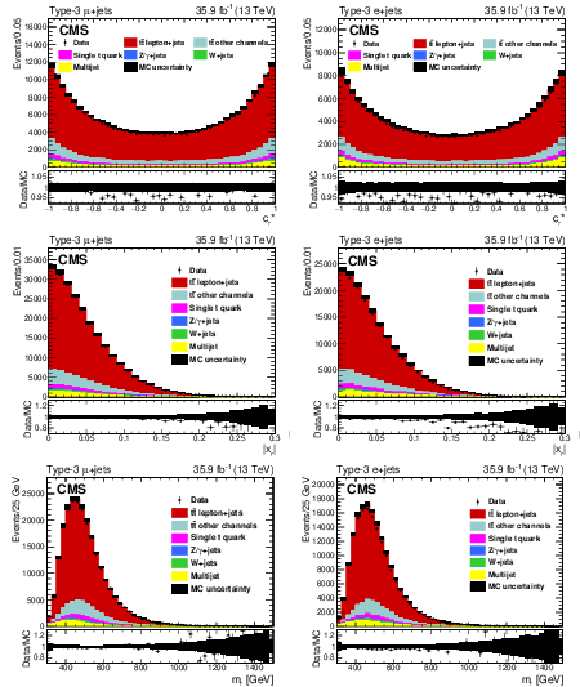
png pdf |
Figure 6:
Data/MC comparison of reconstructed c∗r (upper), |xr| (middle), and mr (lower) for events passing type-3 μ+jets (left column) and e+jets (right column) selection criteria. The MC signal and background show their nominal predictions, with the MC uncertainty pictured in the hatched bands representing statistical uncertainties. The contribution from multijet background is estimated from data, as discussed in Section 6. The lower panels of each figure show the ratio of the observed data to MC expectation in each bin, and the last bins of the |xr| and mr plots include overflow. |
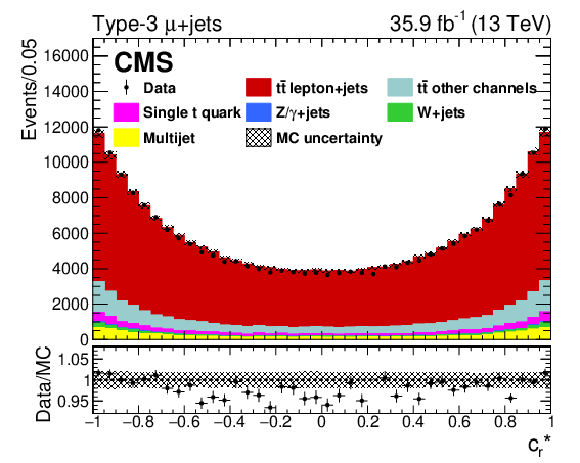
png pdf |
Figure 6-a:
Data/MC comparison of reconstructed c∗r (upper), |xr| (middle), and mr (lower) for events passing type-3 μ+jets (left column) and e+jets (right column) selection criteria. The MC signal and background show their nominal predictions, with the MC uncertainty pictured in the hatched bands representing statistical uncertainties. The contribution from multijet background is estimated from data, as discussed in Section 6. The lower panels of each figure show the ratio of the observed data to MC expectation in each bin, and the last bins of the |xr| and mr plots include overflow. |

png pdf |
Figure 6-b:
Data/MC comparison of reconstructed c∗r (upper), |xr| (middle), and mr (lower) for events passing type-3 μ+jets (left column) and e+jets (right column) selection criteria. The MC signal and background show their nominal predictions, with the MC uncertainty pictured in the hatched bands representing statistical uncertainties. The contribution from multijet background is estimated from data, as discussed in Section 6. The lower panels of each figure show the ratio of the observed data to MC expectation in each bin, and the last bins of the |xr| and mr plots include overflow. |

png pdf |
Figure 6-c:
Data/MC comparison of reconstructed c∗r (upper), |xr| (middle), and mr (lower) for events passing type-3 μ+jets (left column) and e+jets (right column) selection criteria. The MC signal and background show their nominal predictions, with the MC uncertainty pictured in the hatched bands representing statistical uncertainties. The contribution from multijet background is estimated from data, as discussed in Section 6. The lower panels of each figure show the ratio of the observed data to MC expectation in each bin, and the last bins of the |xr| and mr plots include overflow. |
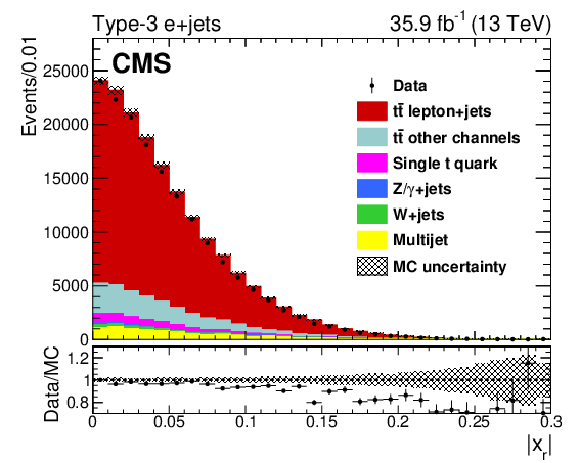
png pdf |
Figure 6-d:
Data/MC comparison of reconstructed c∗r (upper), |xr| (middle), and mr (lower) for events passing type-3 μ+jets (left column) and e+jets (right column) selection criteria. The MC signal and background show their nominal predictions, with the MC uncertainty pictured in the hatched bands representing statistical uncertainties. The contribution from multijet background is estimated from data, as discussed in Section 6. The lower panels of each figure show the ratio of the observed data to MC expectation in each bin, and the last bins of the |xr| and mr plots include overflow. |

png pdf |
Figure 6-e:
Data/MC comparison of reconstructed c∗r (upper), |xr| (middle), and mr (lower) for events passing type-3 μ+jets (left column) and e+jets (right column) selection criteria. The MC signal and background show their nominal predictions, with the MC uncertainty pictured in the hatched bands representing statistical uncertainties. The contribution from multijet background is estimated from data, as discussed in Section 6. The lower panels of each figure show the ratio of the observed data to MC expectation in each bin, and the last bins of the |xr| and mr plots include overflow. |
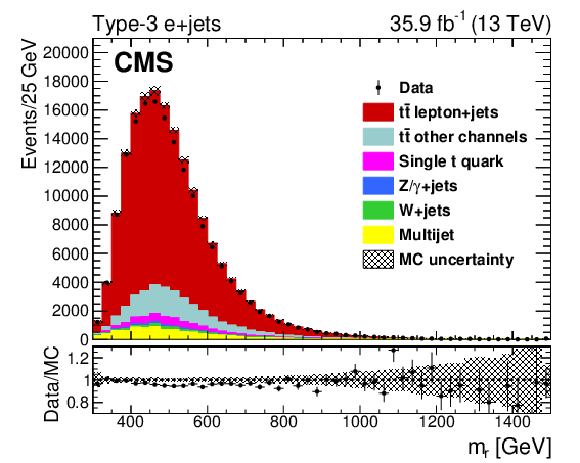
png pdf |
Figure 6-f:
Data/MC comparison of reconstructed c∗r (upper), |xr| (middle), and mr (lower) for events passing type-3 μ+jets (left column) and e+jets (right column) selection criteria. The MC signal and background show their nominal predictions, with the MC uncertainty pictured in the hatched bands representing statistical uncertainties. The contribution from multijet background is estimated from data, as discussed in Section 6. The lower panels of each figure show the ratio of the observed data to MC expectation in each bin, and the last bins of the |xr| and mr plots include overflow. |
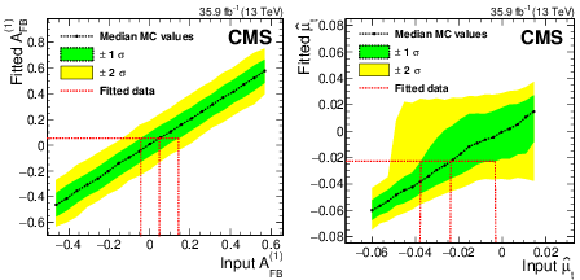
png pdf |
Figure 7:
Neyman constructions for the A(1)FB (left) and ˆμt (right) parameters of interest in groups of 1000 pseudo-experiments generated with systematic uncertainty nuisance parameters allowed to vary. The horizontal dotted lines indicate the values of the parameters determined from the fits and the vertical dotted lines indicate where these values intersect with the central value and uncertainty contours from the pseudo-experiment groups. |
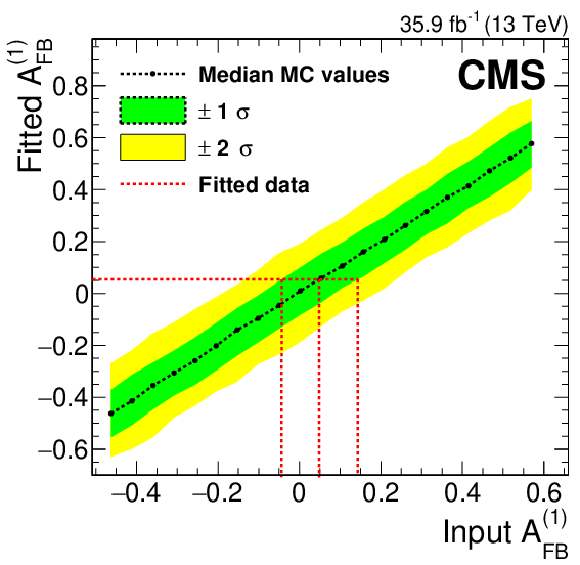
png pdf |
Figure 7-a:
Neyman constructions for the A(1)FB (left) and ˆμt (right) parameters of interest in groups of 1000 pseudo-experiments generated with systematic uncertainty nuisance parameters allowed to vary. The horizontal dotted lines indicate the values of the parameters determined from the fits and the vertical dotted lines indicate where these values intersect with the central value and uncertainty contours from the pseudo-experiment groups. |
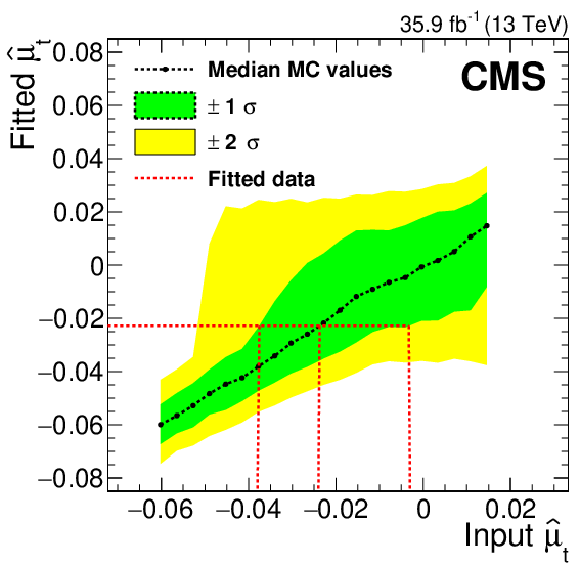
png pdf |
Figure 7-b:
Neyman constructions for the A(1)FB (left) and ˆμt (right) parameters of interest in groups of 1000 pseudo-experiments generated with systematic uncertainty nuisance parameters allowed to vary. The horizontal dotted lines indicate the values of the parameters determined from the fits and the vertical dotted lines indicate where these values intersect with the central value and uncertainty contours from the pseudo-experiment groups. |
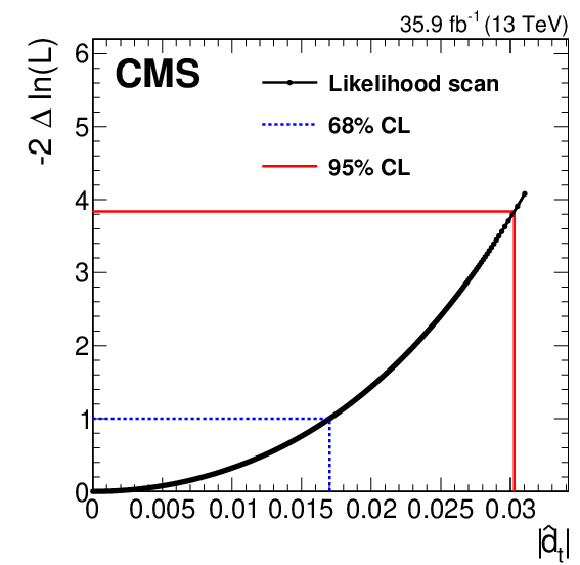
png pdf |
Figure 8:
One-dimensional likelihood profile of the ˆdt parameter, where the change in the minimum log likelihood from its global minimum (−2ΔlnL) is shown on the y-axis as a function of |ˆdt|. The dashed and solid lines show the intersections at −2ΔlnL= 1.0 and 3.84, corresponding to the one-sided limits on |ˆdt| at the 68 and 95% confidence limits, respectively. |
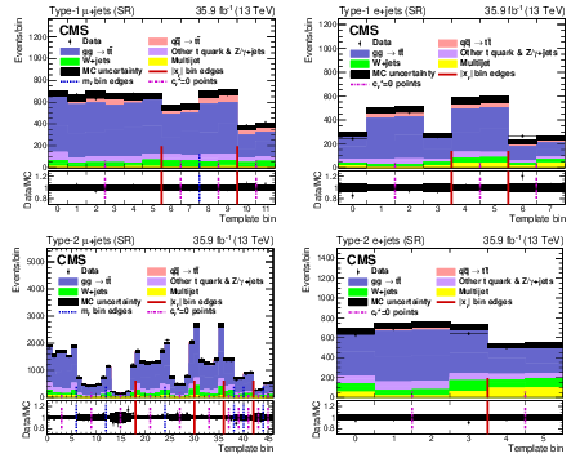
png pdf |
Figure 9:
Comparisons of fitted data and MC expectations as a function of template bin number for the A(1)FB parameter extraction. The plots show events in the type-1 (upper row) and type-2 (lower row) μ+jets (left column) and e+jets (right column) channels, all summed over lepton charge. The MC uncertainty pictured in the hatched bands represents the total (statistical and systematic) uncertainty. The vertical solid, dashed, and dot-dashed lines indicate the edges of the bins in xr and mr and the midpoints of the c∗ distributions, respectively, corresponding to the binning schemes listed in Tables 2-5 in Appendix B. |

png pdf |
Figure 9-a:
Comparisons of fitted data and MC expectations as a function of template bin number for the A(1)FB parameter extraction. The plots show events in the type-1 (upper row) and type-2 (lower row) μ+jets (left column) and e+jets (right column) channels, all summed over lepton charge. The MC uncertainty pictured in the hatched bands represents the total (statistical and systematic) uncertainty. The vertical solid, dashed, and dot-dashed lines indicate the edges of the bins in xr and mr and the midpoints of the c∗ distributions, respectively, corresponding to the binning schemes listed in Tables 2-5 in Appendix B. |
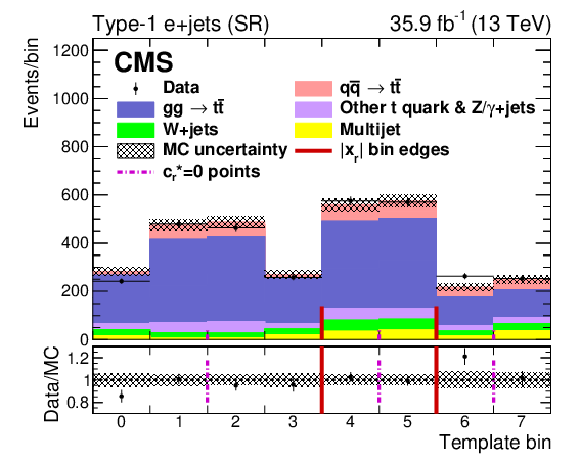
png pdf |
Figure 9-b:
Comparisons of fitted data and MC expectations as a function of template bin number for the A(1)FB parameter extraction. The plots show events in the type-1 (upper row) and type-2 (lower row) μ+jets (left column) and e+jets (right column) channels, all summed over lepton charge. The MC uncertainty pictured in the hatched bands represents the total (statistical and systematic) uncertainty. The vertical solid, dashed, and dot-dashed lines indicate the edges of the bins in xr and mr and the midpoints of the c∗ distributions, respectively, corresponding to the binning schemes listed in Tables 2-5 in Appendix B. |
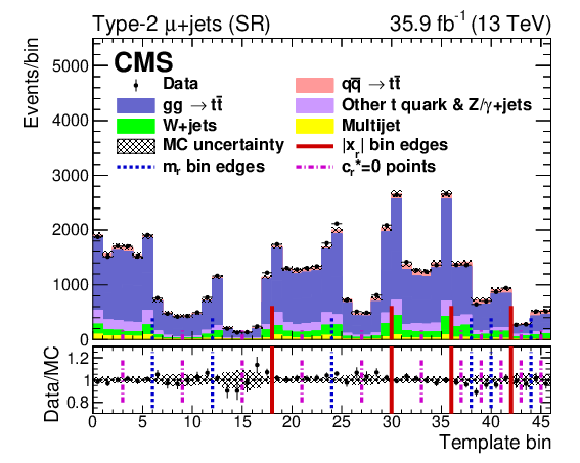
png pdf |
Figure 9-c:
Comparisons of fitted data and MC expectations as a function of template bin number for the A(1)FB parameter extraction. The plots show events in the type-1 (upper row) and type-2 (lower row) μ+jets (left column) and e+jets (right column) channels, all summed over lepton charge. The MC uncertainty pictured in the hatched bands represents the total (statistical and systematic) uncertainty. The vertical solid, dashed, and dot-dashed lines indicate the edges of the bins in xr and mr and the midpoints of the c∗ distributions, respectively, corresponding to the binning schemes listed in Tables 2-5 in Appendix B. |
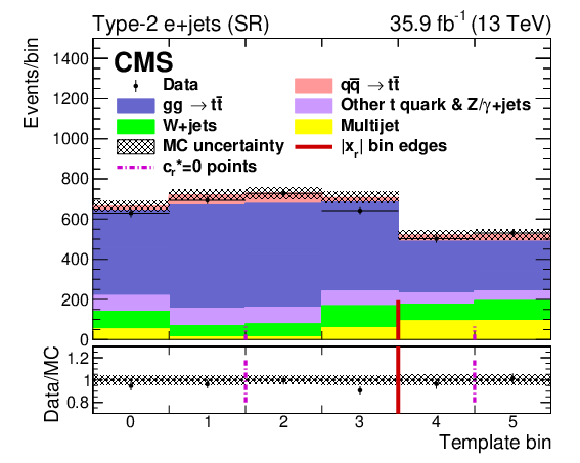
png pdf |
Figure 9-d:
Comparisons of fitted data and MC expectations as a function of template bin number for the A(1)FB parameter extraction. The plots show events in the type-1 (upper row) and type-2 (lower row) μ+jets (left column) and e+jets (right column) channels, all summed over lepton charge. The MC uncertainty pictured in the hatched bands represents the total (statistical and systematic) uncertainty. The vertical solid, dashed, and dot-dashed lines indicate the edges of the bins in xr and mr and the midpoints of the c∗ distributions, respectively, corresponding to the binning schemes listed in Tables 2-5 in Appendix B. |
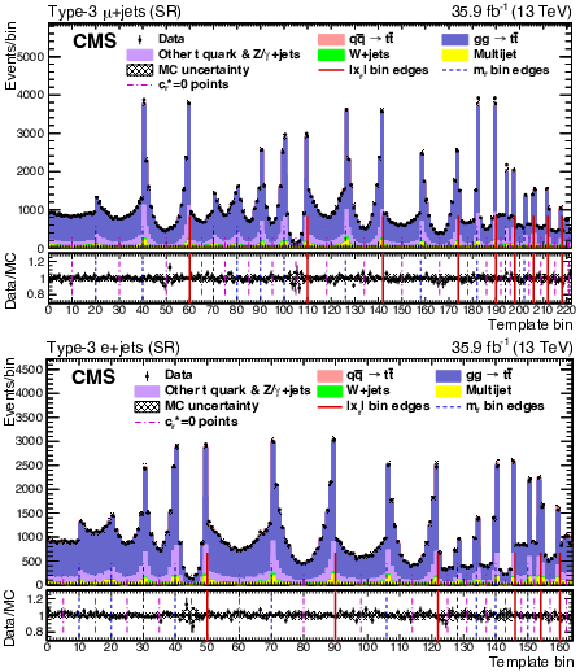
png pdf |
Figure 10:
Comparisons of fitted data and MC expectations as a function of template bin number for the A(1)FB parameter extraction. The plots show events in the type-3 μ+jets (upper) and e+jets (lower) channels, all summed over lepton charge. The MC uncertainty pictured in the hatched bands represents the total (statistical and systematic) uncertainty. The vertical solid, dashed, and dot-dashed lines indicate the edges of the bins in xr and mr and the midpoints of the c∗ distributions, respectively, corresponding to the binning schemes listed in Tables 6 and 7 in Appendix B. |
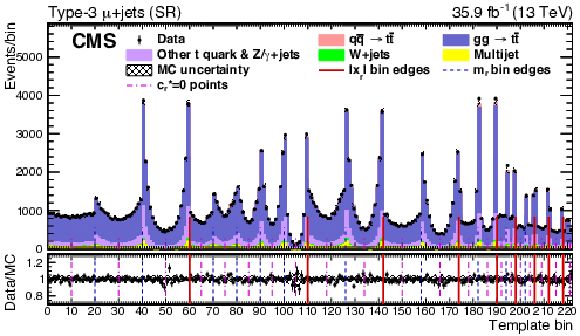
png pdf |
Figure 10-a:
Comparisons of fitted data and MC expectations as a function of template bin number for the A(1)FB parameter extraction. The plots show events in the type-3 μ+jets (upper) and e+jets (lower) channels, all summed over lepton charge. The MC uncertainty pictured in the hatched bands represents the total (statistical and systematic) uncertainty. The vertical solid, dashed, and dot-dashed lines indicate the edges of the bins in xr and mr and the midpoints of the c∗ distributions, respectively, corresponding to the binning schemes listed in Tables 6 and 7 in Appendix B. |
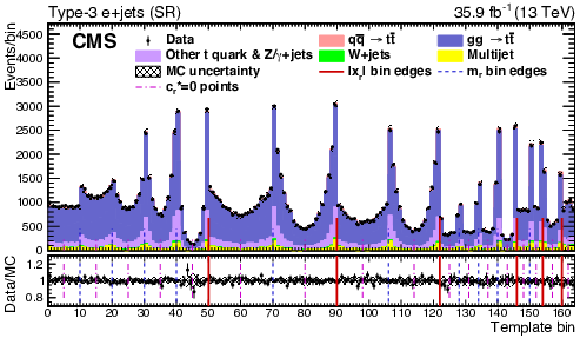
png pdf |
Figure 10-b:
Comparisons of fitted data and MC expectations as a function of template bin number for the A(1)FB parameter extraction. The plots show events in the type-3 μ+jets (upper) and e+jets (lower) channels, all summed over lepton charge. The MC uncertainty pictured in the hatched bands represents the total (statistical and systematic) uncertainty. The vertical solid, dashed, and dot-dashed lines indicate the edges of the bins in xr and mr and the midpoints of the c∗ distributions, respectively, corresponding to the binning schemes listed in Tables 6 and 7 in Appendix B. |
| Tables | |
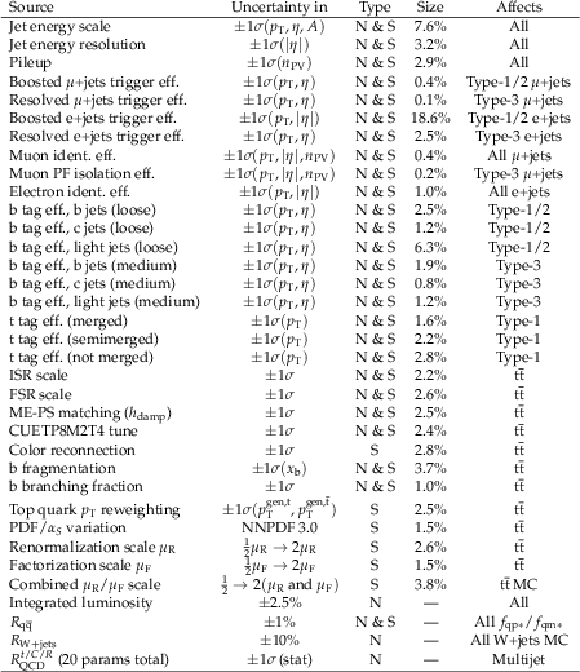
png pdf |
Table 1:
List of nuisance parameters considered in fits to data. The "N" stands for "normalization,'' and "S'' for "shape" of the distribution in the "Type" column. The "Size" column lists the absolute value of the associated fractional shifts averaged over all affected template bins. The quantities Rt/C/RQCD indicate that the QCD multijet yield uncertainties are independent in each topology, channel, and region. |

png pdf |
Table 2:
Template binning in the type-1 μ+jets signal regions (each template has 12 total bins) |

png pdf |
Table 3:
Template binning in the type-1 e+jets signal regions (each template has 8 total bins) |

png pdf |
Table 4:
Template binning in the type-2 μ+jets signal regions (each template has 46 total bins) |

png pdf |
Table 5:
Template binning in the type-2 e+jets signal regions (each template has 6 total bins) |
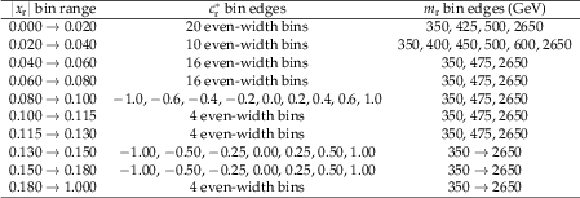
png pdf |
Table 6:
Template binning in the type-3 μ+jets signal regions (each template has 222 total bins) |

png pdf |
Table 7:
Template binning in the type-3 e+jets signal regions (each template has 164 total bins) |
| Summary |
| The linearized parton-level top quark forward-backward asymmetry (A(1)FB) and anomalous chromoelectric (ˆdt) and chromomagnetic (ˆμt) moments have been measured using LHC proton-proton collisions at a center-of-mass energy of 13 TeV, corresponding to an integrated luminosity of 35.9 fb−1. Candidate tˉt events decaying to lepton+jets final states with "resolved" (low-energy) and "boosted" (high-energy) topologies were selected and reconstructed through a kinematic fit of the decay products to tˉt hypotheses. The parameters were extracted from independent template-based likelihood fits to the data based on differential models of extensions to leading-order tree-level cross sections for quark-antiquark and gluon-gluon initial states, yielding A(1)FB= 0.048 +0.095−0.087(stat) +0.020−0.029 (syst), ˆμt=−0.024+0.013−0.009 (stat) +0.016−0.011 (syst), and |ˆdt|< 0.03 at 95% confidence level. |
| References | ||||
| 1 | Particle Data Group, M. Tanabashi et al. | Review of particle physics | PRD 98 (2018) 030001 | |
| 2 | Q.-H. Cao et al. | Forward-backward asymmetry of top quark pair production | PRD 81 (2010) 114004 | 1003.3461 |
| 3 | M. I. Gresham, I.-W. Kim, and K. M. Zurek | On models of new physics for the Tevatron top AFB | PRD 83 (2011) 114027 | 1103.3501 |
| 4 | J. H. Kuhn and G. Rodrigo | Charge asymmetry of heavy quarks at hadron colliders | PRD 59 (1999) 054017 | hep-ph/9807420 |
| 5 | J. H. Kuhn and G. Rodrigo | Charge asymmetries of top quarks at hadron colliders revisited | JHEP 01 (2012) 063 | 1109.6830 |
| 6 | J. A. Aguilar-Saavedra, W. Bernreuther, and Z. G. Si | Collider-independent top quark forward-backward asymmetries: standard model predictions | PRD 86 (2012) 115020 | 1209.6352 |
| 7 | M. Czakon, P. Fiedler, and A. Mitov | Resolving the Tevatron Top Quark Forward-Backward Asymmetry Puzzle: Fully Differential Next-to-Next-to-Leading-Order Calculation | PRL 115 (2015) 052001 | 1411.3007 |
| 8 | D0 Collaboration | First measurement of the forward-backward charge asymmetry in top quark pair production | PRL 100 (2008) 142002 | 0712.0851 |
| 9 | CDF Collaboration | Evidence for a mass dependent forward-backward asymmetry in top quark pair production | PRD 83 (2011) 112003 | 1101.0034 |
| 10 | D0 Collaboration | Measurement of the forward-backward asymmetry in top quark-antiquark production in pˉp collisions using the lepton+jets channel | PRD 90 (2014) 072011 | 1405.0421 |
| 11 | CDF Collaboration | Measurement of the forward-backward asymmetry of top-quark and antiquark pairs using the full CDF Run II data set | PRD 93 (2016) 112005 | 1602.09015 |
| 12 | CDF and D0 Collaborations | Combined forward-backward asymmetry measurements in top-antitop quark production at the Tevatron | PRL 120 (2018) 042001 | 1709.04894 |
| 13 | ATLAS Collaboration | Measurement of the charge asymmetry in top quark pair production in pp collisions at √s= 7 TeV using the ATLAS detector | EPJC 72 (2012) 2039 | 1203.4211 |
| 14 | ATLAS Collaboration | Measurement of the charge asymmetry in highly boosted top-quark pair production in √s=8TeVpp collision data collected by the ATLAS experiment | PLB 756 (2016) 52 | 1512.06092 |
| 15 | CMS Collaboration | Measurement of the charge asymmetry in top-quark pair production in proton-proton collisions at √s= 7 TeV | PLB 709 (2012) 28 | CMS-TOP-11-014 1112.5100 |
| 16 | CMS Collaboration | Measurements of the tˉt charge asymmetry using the dilepton decay channel in pp collisions at √s= 7 TeV | JHEP 04 (2014) 191 | CMS-TOP-12-010 1402.3803 |
| 17 | CMS Collaboration | Measurement of the charge asymmetry in top quark pair production in pp collisions at √s= 8 TeV using a template method | PRD 93 (2016) 034014 | CMS-TOP-13-013 1508.03862 |
| 18 | CMS Collaboration | Measurements of tˉt charge asymmetry using dilepton final states in pp collisions at √s= 8 TeV | PLB 760 (2016) 365 | CMS-TOP-15-009 1603.06221 |
| 19 | D. Atwood, A. Aeppli, and A. Soni | Extracting anomalous gluon-top effective couplings at the supercolliders | PRL 69 (1992) 2754 | |
| 20 | D. Atwood, A. Kagan, and T. G. Rizzo | Constraining anomalous top quark couplings at the Tevatron | PRD 52 (1995) 6264 | hep-ph/9407408 |
| 21 | P. Haberl, O. Nachtmann, and A. Wilch | Top production in hadron-hadron collisions and anomalous top-gluon couplings | PRD 53 (1996) 4875 | hep-ph/9505409 |
| 22 | K.-M. Cheung | Probing the chromoelectric and chromomagnetic dipole moments of the top quark at hadronic colliders | PRD 53 (1996) 3604 | hep-ph/9511260 |
| 23 | CMS Collaboration | Measurements of tˉt spin correlations and top quark polarization using dilepton final states in pp collisions at √s= 8 TeV | PRD 93 (2016) 052007 | CMS-TOP-14-023 1601.01107 |
| 24 | P. Nason | A new method for combining NLO QCD with shower Monte Carlo algorithms | JHEP 11 (2004) 040 | hep-ph/0409146 |
| 25 | S. Frixione, P. Nason, and C. Oleari | Matching NLO QCD computations with parton shower simulations: the POWHEG method | JHEP 11 (2007) 070 | 0709.2092 |
| 26 | S. Alioli, P. Nason, C. Oleari, and E. Re | A general framework for implementing NLO calculations in shower Monte Carlo programs: the POWHEG BOX | JHEP 06 (2010) 043 | 1002.2581 |
| 27 | J. C. Collins and D. E. Soper | Angular distribution of dileptons in high-energy hadron collisions | PRD 16 (1977) 2219 | |
| 28 | CMS Collaboration | The CMS experiment at the CERN LHC | JINST 3 (2008) S08004 | CMS-00-001 |
| 29 | CMS Collaboration | The CMS trigger system | JINST 12 (2017) P01020 | CMS-TRG-12-001 1609.02366 |
| 30 | CMS Collaboration | Particle-flow reconstruction and global event description with the CMS detector | JINST 12 (2017) P10003 | CMS-PRF-14-001 1706.04965 |
| 31 | M. Cacciari, G. P. Salam, and G. Soyez | The anti-kT jet clustering algorithm | JHEP 04 (2008) 063 | 0802.1189 |
| 32 | M. Cacciari, G. P. Salam, and G. Soyez | FastJet user manual | EPJC 72 (2012) 1896 | 1111.6097 |
| 33 | CMS Collaboration | Performance of missing transverse momentum reconstruction in proton-proton collisions at √s= 13 TeV using the CMS detector | JINST 14 (2019) P07004 | CMS-JME-17-001 1903.06078 |
| 34 | CMS Collaboration | Jet energy scale and resolution in the CMS experiment in pp collisions at 8 TeV | JINST 12 (2017) P02014 | CMS-JME-13-004 1607.03663 |
| 35 | CMS Collaboration | Jet performance in pp collisions at √s= 7 TeV | CMS-PAS-JME-10-003 | |
| 36 | M. Dasgupta, A. Fregoso, S. Marzani, and G. P. Salam | Towards an understanding of jet substructure | JHEP 09 (2013) 029 | 1307.0007 |
| 37 | A. J. Larkoski, S. Marzani, G. Soyez, and J. Thaler | Soft drop | JHEP 05 (2014) 146 | 1402.2657 |
| 38 | Y. L. Dokshitzer, G. D. Leder, S. Moretti, and B. R. Webber | Better jet clustering algorithms | JHEP 08 (1997) 001 | hep-ph/9707323 |
| 39 | M. Wobisch and T. Wengler | Hadronization corrections to jet cross-sections in deep inelastic scattering | in Proceedings of the Workshop on Monte Carlo Generators for HERA Physics, Hamburg, Germany, p. 270 1998 | hep-ph/9907280 |
| 40 | CMS Collaboration | Jet algorithms performance in 13 TeV data | CDS | |
| 41 | CMS Collaboration | CMS luminosity measurements for the 2016 data taking period | CMS-PAS-LUM-17-001 | CMS-PAS-LUM-17-001 |
| 42 | S. Frixione, P. Nason, and G. Ridolfi | A positive-weight next-to-leading-order Monte Carlo for heavy flavour hadroproduction | JHEP 09 (2007) 126 | 0707.3088 |
| 43 | T. Sjostrand et al. | An Introduction to PYTHIA 8.2 | CPC 191 (2015) 159 | 1410.3012 |
| 44 | CMS Collaboration | Investigations of the impact of the parton shower tuning in PYTHIA 8 in the modelling of t¯t at √s= 8 and 13 TeV | CMS-PAS-TOP-16-021 | CMS-PAS-TOP-16-021 |
| 45 | A. Kalogeropoulos and J. Alwall | The SysCalc code: A tool to derive theoretical systematic uncertainties | 1801.08401 | |
| 46 | M. Cacciari et al. | The tˉt cross-section at 1.8 TeV and 1.96 TeV: A study of the systematics due to parton densities and scale dependence | JHEP 04 (2004) 068 | hep-ph/0303085 |
| 47 | S. Catani, D. de Florian, M. Grazzini, and P. Nason | Soft gluon resummation for Higgs boson production at hadron colliders | JHEP 07 (2003) 028 | hep-ph/0306211 |
| 48 | NNPDF Collaboration | Parton distributions for the LHC Run II | JHEP 04 (2015) 040 | 1410.8849 |
| 49 | S. Alioli, P. Nason, C. Oleari, and E. Re | NLO single-top production matched with shower in POWHEG: s- and t-channel contributions | JHEP 09 (2009) 111 | 0907.4076 |
| 50 | P. Artoisenet, R. Frederix, O. Mattelaer, and R. Rietkerk | Automatic spin-entangled decays of heavy resonances in Monte Carlo simulations | JHEP 03 (2013) 015 | 1212.3460 |
| 51 | E. Re | Single-top Wt-channel production matched with parton showers using the POWHEG method | EPJC 71 (2011) 1547 | 1009.2450 |
| 52 | J. Alwall et al. | The automated computation of tree-level and next-to-leading order differential cross sections, and their matching to parton shower simulations | JHEP 07 (2014) 079 | 1405.0301 |
| 53 | J. Alwall et al. | Comparative study of various algorithms for the merging of parton showers and matrix elements in hadronic collisions | EPJC 53 (2008) 473 | 0706.2569 |
| 54 | GEANT4 Collaboration | GEANT4--a simulation toolkit | NIMA 506 (2003) 250 | |
| 55 | P. Kant et al. | HatHor for single top-quark production: updated predictions and uncertainty estimates for single top-quark production in hadronic collisions | CPC 191 (2015) 74 | 1406.4403 |
| 56 | N. Kidonakis | Two-loop soft anomalous dimensions for single top quark associated production with a W or H | PRD 82 (2010) 054018 | 1005.4451 |
| 57 | R. Gavin, Y. Li, F. Petriello, and S. Quackenbush | W Physics at the LHC with FEWZ 2.1 | CPC 184 (2013) 208 | 1201.5896 |
| 58 | R. Gavin, Y. Li, F. Petriello, and S. Quackenbush | FEWZ 2.0: A code for hadronic Z production at next-to-next-to-leading order | CPC 182 (2011) 2388 | 1011.3540 |
| 59 | Y. Li and F. Petriello | Combining QCD and electroweak corrections to dilepton production in FEWZ | PRD 86 (2012) 094034 | 1208.5967 |
| 60 | M. Czakon and A. Mitov | Top++: a program for the calculation of the top pair cross section at hadron colliders | CPC 185 (2014) 2930 | 1112.5675 |
| 61 | J. Thaler and K. Van Tilburg | Identifying boosted objects with N-subjettiness | JHEP 03 (2011) 015 | 1011.2268 |
| 62 | CMS Collaboration | Identification of heavy-flavour jets with the CMS detector in pp collisions at 13 TeV | JINST 13 (2018) P05011 | CMS-BTV-16-002 1712.07158 |
| 63 | J. Erdmann et al. | A likelihood-based reconstruction algorithm for top-quark pairs and the KLFitter framework | NIMA 748 (2014) 18 | 1312.5595 |
| 64 | F. James and M. Roos | Minuit: a system for function minimization and analysis of the parameter errors and correlations | CPC 10 (1975) 343 | |
| 65 | CMS Collaboration | Search for resonant tˉt production in lepton+jets events in pp collisions at √s= 7 TeV | JHEP 12 (2012) 015 | CMS-TOP-12-017 1209.4397 |
| 66 | CMS Collaboration | Measurement of the inelastic proton-proton cross section at √s= 13 TeV | JHEP 07 (2018) 161 | CMS-FSQ-15-005 1802.02613 |
| 67 | M. Czakon et al. | Top-pair production at the LHC through NNLO QCD and NLO EW | JHEP 10 (2017) 186 | 1705.04105 |
| 68 | CMS Collaboration | Search for new physics in top quark production in dilepton final states in proton-proton collisions at √s= 13 TeV | EPJC 79 (2019) 886 | CMS-TOP-17-020 1903.11144 |
| 69 | J. Butterworth et al. | PDF4LHC recommendations for LHC Run II | JPG 43 (2016) 023001 | 1510.03865 |
| 70 | J. Rojo et al. | The PDF4LHC report on PDFs and LHC data: results from run I and preparation for run II | JPG 42 (2015) 103103 | 1507.00556 |
| 71 | A. Accardi et al. | A critical appraisal and evaluation of modern PDFs | EPJC 76 (2016) 471 | 1603.08906 |
| 72 | S. Argyropoulos and T. Sjostrand | Effects of color reconnection on tˉt final states at the LHC | JHEP 11 (2014) 043 | 1407.6653 |
| 73 | J. R. Christiansen and P. Z. Skands | String formation beyond leading colour | JHEP 08 (2015) 003 | 1505.01681 |
| 74 | H. Landsman | b-quark fragmentation and gluon splitting to b anti-b (LEP) | in Proceedings, 11th International Workshop on Deep Inelastic Scattering (DIS 2003): St. Petersburg, Russia, April 23-27 | |
| 75 | J. S. Conway | Incorporating nuisance parameters in likelihoods for multisource spectra | in Proceedings, PHYSTAT 2011 Workshop on Statistical Issues Related to Discovery Claims in Search Experiments and Unfolding, CERN, Geneva, Switzerland, January 17-20 | 1103.0354 |
| 76 | J. Neyman | Outline of a theory of statistical estimation based on the classical theory of probability | Philos. Trans. Royal Soc. A 236 (1937) 333 | |
| 77 | G. Cowan, K. Cranmer, E. Gross, and O. Vitells | Asymptotic formulae for likelihood-based tests of new physics | EPJC 71 (2011) 1554 | 1007.1727 |
| 78 | S. Baker and R. D. Cousins | Clarification of the use of chi-square and likelihood functions in fits to histograms | Nucl. Instrum. Methods Phys. Res 221 (1984) 437 | |
| 79 | CMS Collaboration | Measurement of the top quark polarization and tˉt spin correlations using dilepton final states in proton-proton collisions at √s= 13 TeV | PRD 100 (2019) 072002 | CMS-TOP-18-006 1907.03729 |

|
Compact Muon Solenoid LHC, CERN |

|

|

|

|

|

|